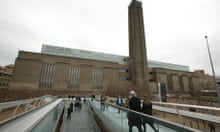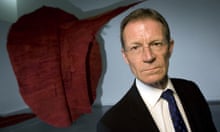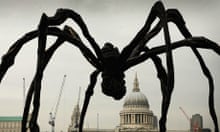Since it began in 2000, the Unilever series of annual commissions in Tate Modern's Turbine Hall has become the most significant long-term project instigated by any museum in the early 21st century. There are now similar installations in Paris and New York, and the series has developed its own cumulative energy. Let's hope this is sustained through the current economic crisis.
Invitations to participate are increasingly daunting for artists. The Turbine Hall presents an enormous opportunity, but also a huge career risk. One doesn't want overblown monstrosities, or for artists just to make grandiose versions of the kind of things they have done elsewhere. The space is too compromised for Richard Serra, for instance, who installed a great work in Paris's Grand Palais in 2008.
What I'm always hungry for is artists who turn us back on ourselves, who provide an experience that refreshes the way we think. I want them not to perform according to type, but to queer the space and make us think about art and ourselves differently.
The appeal of the spectacle, for a singular and gobsmacking novelty, is hard to resist. The best artists have not gone for the obvious. But however subtle their proposal, and no matter how serious their intent, Doris Salcedo's Shibboleth still became Doris's Crack, while Olafur Eliasson's The Weather Project had the public using the mirrored roof to spell out rude phrases with their own bodies as they lay on the floor below. The recent How It Is, by Miroslaw Balka, seemed an invitation for spooked-out blunderings and fumbles in the dark. There are better ways of looking.
The Turbine Hall is the most public museum space anywhere, and is spectacular in itself. Being here is like being in a stupid movie we have already seen. To show here is a test of an artist's capacity and ingenuity. No one accepts the commission lightly, and no one can get away with going through the motions. This is exhilarating. The series has demonstrated the limits and capabilities of artists, of their work and ideas. In an age of spectacle, it continues to put art itself to the test.
Adrian Searle
2000 Louise Bourgeois: Maman
Bourgeois will be 100 next year, and no longer gives interviews, so the fact she's even speaking to me proves how much the first Turbine Hall commission meant to her. The twisted steel legs of her giant spider Maman, alongside a sequence of fabulous, hellish towers, gave the brand-new Tate Modern an instant visual signature, and made the then 89-year-old French-born New York artist a household name. Until then, Bourgeois had been revered by a small world of contemporary art fans; did this sudden popularity surprise her? "No," she says modestly. "The space is so beautiful – anything placed inside it would cause a strong reaction."
As an artist, Bourgeois dwells on the strange and darkly remembered interiors of her childhood; the intensity of her meditations on sexuality and power easily filled the colossal space. Maman turned the surrealist obsession with the male psyche on its head, creating a haunting image of motherhood – a spider carrying her eggs.
Before this, Bourgeois says, "I made a series of small sculptures with mirrors and chairs. They were about looking and being looked at. To continue these concepts on a large scale was an opportunity I could not pass up." What mattered to her most about this installation was the audience's engagement with it. Her towers were designed to be ascended, paving the way for subsequent participatory installations. "The towers were meant to be an experience. If you did not experience all three towers in sequence, then you did not get the piece."
Did Maman affect future work? She says not, beyond the opportunities afforded by scale; As she points out, her work is relatively immune to outside influences: "It has an internal logic all its own." Jonathan Jones
2001 Juan Muñoz: Double Bind
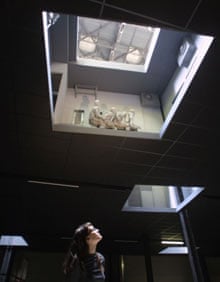
After completing Double Bind in June 2001, Muñoz said he wanted to retreat from constant travel and exhibitions. He had just finished preparing a mid-career survey show, to open in the US that October. He wanted to pay more attention to drawing and to his writing, both of which he felt he had neglected. He died suddenly in August that year, aged 48, while on holiday with his family in Ibiza. The things he had been writing that summer have been lost, somewhere in the hard drive of a broken laptop.
Muñoz was extremely aware of the potential this space offered, but also the risk. "It's a killer," he told me as we stood on an upper level of the gallery, looking down, just before his project was announced. The problems of installation were both artistic and technical. There were arguments and accidents. He had wanted to place figures on the false floor he constructed at the level of the bridge, where, in the distance, he had also installed a pair of empty lifts that rose and fell through the full height of the space. But in the end, he said, the floor resisted whatever figures he put there. Instead, it became a vast image of unapproachable emptiness. There were figures, little groups of them, in the cavities between the floor and the false ceiling he created below it. Despite the crowds and the work's complexity, there was something pensive about Double Bind. It induced feelings of solitude and wonderment.
I think Muñoz saw this as a summation and the beginning of a new phase of work. Since his death, there have been proposals to reinstall it in various locations, none of which the artist had in mind. The Atocha station in Madrid was one such possibility, an idea curtailed by the al-Qaida bombings of 2004. An old warehouse on the river in Bilbao was also considered when his Tate Modern retrospective travelled there in 2008. As it is, all the elements remain in storage. AS
2002 Anish Kapoor: Marsyas
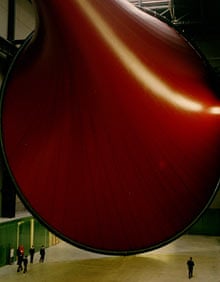
The title of Kapoor's vast scarlet trumpet referred to the late Titian of that name: a depiction of the mythological character Marsyas, flayed alive by the god Apollo. The most obvious aspect of Kapoor's piece, a "skin" stretched over a frame, was its scale: it was almost too big for the space, and that was the point.
Though it divided critics, some of whom thought it bombastic, Kapoor remains delighted by Marsyas. "Just a big thing is boring," he explains, "but a big thing with another purpose can be awe-inspiring. Marsyas did everything I wanted. I wanted it to occupy a space that hadn't been imagined, [to be] a work that wasn't viewable as a whole, but in bits."
Visiting the sculpture after it was installed, "was the first time I had been able to get to know the work. You'd go in, and visitors were having exactly the same experience I was." In particular, people noticed the hum of the electricity substation next door – almost as if it came from the sculpture. Kapoor laughs: "Yes, I think it's a low G, actually." The piece formed a backdrop to an impassioned anti-war staging directed by Peter Sellars, while Arvo Pärt composed a work in its honour. (Of the Sellars, Kapoor says cautiously: "When Peter's pieces become agit-prop, they can become a little overwhelming.")
The commission taught him some practical lessons. "It needs to be organised as a real campaign. You have to install it over two to three weeks – it's got to happen quickly." Since then, he has resisted the more grandiose offers that have come his way. But next year, Kapoor will take on one of Europe's biggest and most intimidating spaces, Paris's Grand Palais – almost as scary as the Turbine Hall itself. Charlotte Higgins
2003 Olafur Eliasson: The Weather Project
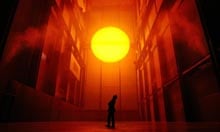
"At the time, I was incredibly happy with people's reactions – they were so diverse," Eliasson says of the gigantic wintry sun he installed at the far end of the hall. All through the winter of 2003/4, visitors basked in its orange light and saw themselves reflected in the mirrored ceiling the artist installed high up near the roof. "It had its own life. There was a sense of personal and collective experience: they're not opposites. The work sailed off into the realm of the public, but it's like when a big ship goes adrift – where will it end up? The Weather Project entered popular culture, and there were some who wrapped it all up in to some kind of new age, universalistic ritual – this I didn't like."
Eliasson thinks earlier projects linked the work with the gallery in a way his did not. "My project brought the city spilling in, and there was a collapse in the contract of how you are supposed to behave in a museum. Public space is becoming ever more controlled, while the Turbine Hall is more relaxed. Museums want objects, but reality changes that. With these projects, the museum itself begins to produce reality."
Eliasson welcomes this development, with some reservations. "Projects like these mostly happen in close agreement with market-driven thinking, which leads to little diversity. Everything comes at a price. But as a space, this is old and quirky, and it still shifts with every commission. There are plenty more projects in front of us. I am happy to have set the standard." AS
2004 Bruce Nauman: Raw Materials
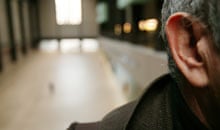
On his first site visit after having been invited to undertake the fifth Turbine Hall commission, Nauman remembers that "a number of large Henry Moore pieces were arranged on the floor beyond the bridge. My first thought was to fly the sculptures around the space using the two gantry cranes below the roof structure."
Some proposals inevitably go beyond the feasible, and the American artist rejected this initial, startling idea. Nauman once made a sculpture called Henry Moore Bound to Fail, and has also remarked that we never know when the grand old man of British modernism might come in handy again. In the end, he returned to his own work and decided to limit himself entirely to sound.
Raw Materials directed our walk down the ramp and through the hall via a succession of human voices (including the artist's), revisiting 22 of the texts and soundtracks of earlier works. The piece was inspired by the gallery's incessant hum (the buzz from that electrical substation again). "The deep variable sound was persistent throughout the space, and eventually it occurred to me that the texts and voices, sung or spoken, that I have used over the years could be incorporated. The large number of people and the various ways to enter and leave the space – meeting, talking, eating lunch, making a public space private – all contributed to the idea of using these sounds to redefine and direct the experience. I don't know why I didn't use some of the non-verbal sounds as well.
"It has taken some time after this installation to use this [way of working] with large spaces again. Sometimes it requires a long period to digest this kind of risk." AS
2005 Rachel Whiteread: Embankment
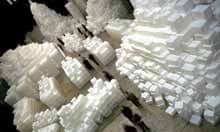
Whiteread says Embankment liberated a new playfulness in her work. Certainly, hers was a remarkably introspective and personal sculpture for this space. Tottering icebergs, crumbling Carrara marble quarries, the sprawl of a Bernini fountain: these were some of the associations provoked by her thousands of white boxes, arranged to tower over visitors.
Whiteread had recently visited the Arctic. "I really wanted to use the whiteness of the landscape and to bring that inside. Where we were, no one had trodden before, and lichen was the only thing that was growing. We had to be together all the time, and it was very claustrophobic. Here, I wanted to make something really gargantuan and breathtaking."
Yet its use of boxes began in grief. "The starting point was my mother's house: she had died a year before and we were clearing it out. There was one box I had used for Christmas decorations when I was a child. From this came the casting of 14,000 more. All my work has an emotional starting point, but I wanted it to be completely recyclable. Afterwards, we recycled it all on site."
She directed the installers by walkie-talkie. "I made a maquette. You need to be prepared. I'm very much a hands-on artist, and it's difficult to work in there because it's so public. [But] it was very freeing, being able to build massive areas and then go to the bridge and take it all down again. It was like playing with giant building blocks. I had a letter the other day from an 83- year-old woman about it." She had meant to write at the time, to say how much she admired it.
Whiteread admits to being sceptical of some of the other commissions. "I don't think all the artists have responded well: it's been about 50:50. You can deal with it in a very theatrical way, as Eliasson did – that was like being at Glastonbury. Some of the others that have been more participatory I've struggled with." JJ
2006 Carsten Höller: Test Site
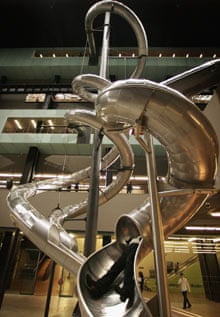
Höller had visitors queueing and screaming and slithering down his spiralling slides. It was fun, though there were those who wondered whether it was really art. But art, Höller tells me, is changing its character, like it or not. In the 1970s, projects such as Robert Smithson's Spiral Jetty were of minority interest. In London, Höller says, "every newspaper wrote about Test Site, and every taxi driver knew about the slides. British popular culture embraces something like this in a way other countries don't."
So the Turbine Hall became a playground. Höller doesn't believe that the hunger for spectacle signals the death of art: it's just a logical consequence of what came before. "It is a very tricky, strange development," he says. He was overwhelmed by the public's response and concerned by the uniformity of much of the coverage. "I was trying to make a serious architectural contribution – and to ask, why don't we use slides everywhere? I was also dealing with the space, all those grids and straight lines. Putting the slides there was an artistic, even poetic intervention. The spirals relate to natural growth and form. No one mentioned this. I wanted to make the people part of the work, but you didn't have to use the slides. Standing and watching could be like looking at a painting by [Hieronymous] Bosch."
While it is becoming a bigger challenge for each new artist who takes it on, Höller is adamant the series should continue. Other countries now mount similar projects, but "this is the first one. And you can't pretend this is just an ordinary space. It's one of the few spaces in the world that has this fantastic possibility. There is no way back." AS
2007 Doris Salcedo: Shibboleth
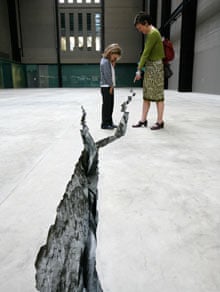
When Salcedo was designing Shibboleth, a long crack running the length of the hall, she imagined it would be quiet and elusive in impact. "I thought it was an extremely humble piece. I saw it as an angry piece, but basically defined by a radical absence. I imagined it was going to be overlooked by visitors." So she was startled by both the blanket media coverage and the intensity of the public response, ranging from fascination to dismissal, as people came to gawp at (and even fall into) Tate Modern's hole.
It started with politics. "I am a third-world person [she is Colombian], and came as such to this modernist, industrial space that has become one of the main – if not the main – cultural centres in Europe. Many questions were raised: questions about the relationship non-Europeans have with European modernity, and with European culture in general. I had to bring to that public space the obliterated history of defeated peoples."
Excavating the floor with a team of engineers was not difficult. "I had been making anti-architecture for several years, so the scale was not an issue. I am not a solo singer. For the past 13 years, I have been working with architects and engineers." The more difficult part was the response from press and public: "There were all kinds of interpretations – some quite insightful, others full of cynicism. Most articles remain obsessed by the supposed dangers of the piece. I think that was the easiest way out of thinking about the issues it addressed."
Is the Turbine Hall a place where serious ideas can be raised, or does its reputation for spectacle get in the way of true engagement? "I believe the accidents that took place were the result of a lack of attention," Salcedo says. "Art is about experience, and that experience will reveal itself only when the viewer silently contemplates the piece. Neither I nor Shibboleth can be blamed for that terrible lack." JJ
2008 Dominique Gonzalez-Foerster: TH.2058
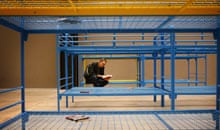
Set 50 years into the future, Gonzalez-Foerster's wry take on art and the apocalypse filled the Turbine Hall with the patter of a biblical deluge, super-sized sculptures seemingly swollen with rain, metal bunks strewn with disaster literature and a big-screen montage of end-of-the-world film clips.
Walking around the hall now, she says that "working with the scale of the space is like the difference between a short and a feature film". Her blown-up copies of works such as Louise Bourgeois's spider were realised by a props team from Pinewood Studios. Gonzalez-Foerster remembers: "The hall looked like a giant puppet theatre. There were so many cables holding the sculptures. I discovered a new group of people: riggers!"
What happened when the plastic curtains that marked the entrance were finally parted by her cast of imaginary refugees, the public? "After one month, almost all the books had disappeared," she says. Nearly 1,000 of them, by Jorge Luis Borges, JG Ballard and others, had to be replaced. It was the many photographs posted on Flickr that proved the high point. "This was a big editing moment, connecting different fields of culture. For a lot of visitors, it became their own montage." The critics, she feels, tended to pass over the references. "They wrote a lot about the beds. Why the beds? For me, they're only part of it, like the chairs in a cinema."
Already, TH.2058 has inspired two new works. In its final week, the installation served as the set for Gonzalez-Foerster's film Noreturn, in which a group of children get locked inside a museum; the Spanish writer Enrique Vila-Matas put TH.2058 in his latest novel, Dublinesca. This was one of the best things, she says, "that something dealing with fiction [has gone] back to fiction". Skye Sherwin
2009 Miroslav Balka: How It Is
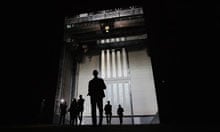
Balka took his title from a terse, late work by Samuel Beckett and analysed each of the earlier projects in order to develop his own. "What other artists have done is part of the deal. It's good that some of the branches of possibility are cut off. In a way, my project was a dialogue with Olafur Eliasson's. I created a sort of negative situation to his. London is open and international: I wanted to create its opposite. You have to deal with spectacularisation, but I wanted to show and not show, " he says. "It's a serious task."
He didn't spend much time observing the way people engaged with his big steel box and its impenetrably dark, felt-lined interior. "I just wanted the last day to be over. I had anxiety dreams that someone would switch on the light." How It Is will now be recycled. The artist jokes: "I had an idea to send it to the desert in New Mexico, to stand in the sun with nothing but snakes and stones around it."
Balka's next project will involve showing his own work alongside that of northern Renaissance painters, including Hans Baldung and Matthias Grünewald. "After How It Is, I wanted to return to a relationship with humility. I like the word humility. I don't know if something like this will happen again in my life."
What's fascinating about the series, Balka says, is the growing conversation between artists. "Ai Weiwei is a great choice for the next commission [in October this year], because he doesn't come from the western, essentially European tradition – which even Bruce Nauman and Doris Salcedo belong to. It's time for the Chinese tiger to jump over the bridge of the Turbine Hall." AS
Send us your photographs
Email your best shot of a Turbine Hall installation to your.pictures@guardian.co.uk – we will print a selection in G2. By submitting your photograph you agree to our terms and conditions (see guardian.co.uk/terms). Tate Modern celebrates its 10th birthday with a free festival of art and music, 14-16 May. Details: tate.org.uk

